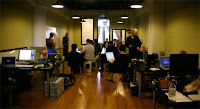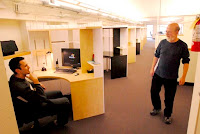We love hearing our policy makers and other economic leaders touting entrepreneurship and innovation as the prescription for our current economic ills. At Golden Capital Network we’ve been prescribing this for the last 10 years. Even so, we still periodically have to stop and clarify internally for ourselves the nuance of words like “entrepreneur” and “innovation.” They are more ambiguous than they might seem.
“Entrepreneur” is vexing not only for its difficulty to spell and pronounce, but because not all entrepreneurs are created equal. Yet there is no easy way to distinguish between them. Is the corner hot dog vendor an entrepreneur? Sure he is. But how closely related is the hot dog vendor to the 150 employee solar hot water heater manufacturer, or the 400 employee craft brewery, or the five person licensing shop with patents to use UV light to cure everything from crop rot to toenail fungus (to crib just a few real world examples from our own backyard here in far Northern California)?
Are mom and pop hot dog cart vendors, or other regional small businesses like them who sell products and services exclusively to a local market, going to bail us out of our economic doldrums? Probably not very quickly. Regional lifestyle companies are important to the economic mix, but in terms of economic impact, when we think about “entrepreneurs,” we like to think about companies that are “scaleable.”
Scaleability, to us, indicates how large and quickly a firm can grow, and it is a critical distinction among entrepreneurial ventures. Scaleability depends on the market, the products, and not to be overlooked, the aspirations of the actual entrepreneur. All the data indicate that scaleable companies have the highest potential to affect real, positive change within regional economies. They also show that entrepreneurs who were successful scaling large enterprise did so based on another, equally ambiguous concept: “innovation.”
The word “innovation” can be as troubling as “entrepreneur” in terms of misuse and misunderstanding. Steve Lohr, a longtime staff writer for the New York Times, helped us considerably with this one recently when he contrasted “innovation” with “invention.”
“Invention is coming up with a break-through idea… Innovation is the process that translates that knowledge into economic growth and social well being,” Lohr wrote in a Nov. 12 article profiling the Kauffman Foundation. “Invention is science. Innovation is economics.”
Innovation, in our experience is the application of new ideas, including technology and other inventions, in a commercial environment. Technology by itself is not necessarily an innovation, nor is an innovation necessarily technologic. It’s all in how the entrepreneur uses a technology, idea or invention to solve a problem that has a commercial impact, either internally to improve functions and operations in his or her own company, or externally as a product offering for the marketplace. This is the crux of “innovation.”
In the economic development industry, where we ultimately hang our hats here at GCN, the recent trend has been to use “technology entrepreneurship” or “technology economic development” as the phrase du jour. This might work in places like Silicon Valley or
Already we are seeing phrases like “innovation economic development,” “innovation economics,” “innovation brokering,” and “innovation facilitation” crop up to reflect this newer, more refined understanding of the nuance of how innovation and entrepreneurship interact on the ground and in the marketplace. At Golden Capital Network, where our mission for the past 10 years has been to “foster innovation growth entrepreneurship for economic development,” now that more people might get what we've been talking about, maybe we can get more done.














 A colleague from my former story arc in Silicon Valley posted a very interesting essay today about the uneasy relationship between product management and risk management, and how it showed up in the Google Chrome launch. Some excellent insights for anyone developing software products from Jeffrey McManus.
A colleague from my former story arc in Silicon Valley posted a very interesting essay today about the uneasy relationship between product management and risk management, and how it showed up in the Google Chrome launch. Some excellent insights for anyone developing software products from Jeffrey McManus.




